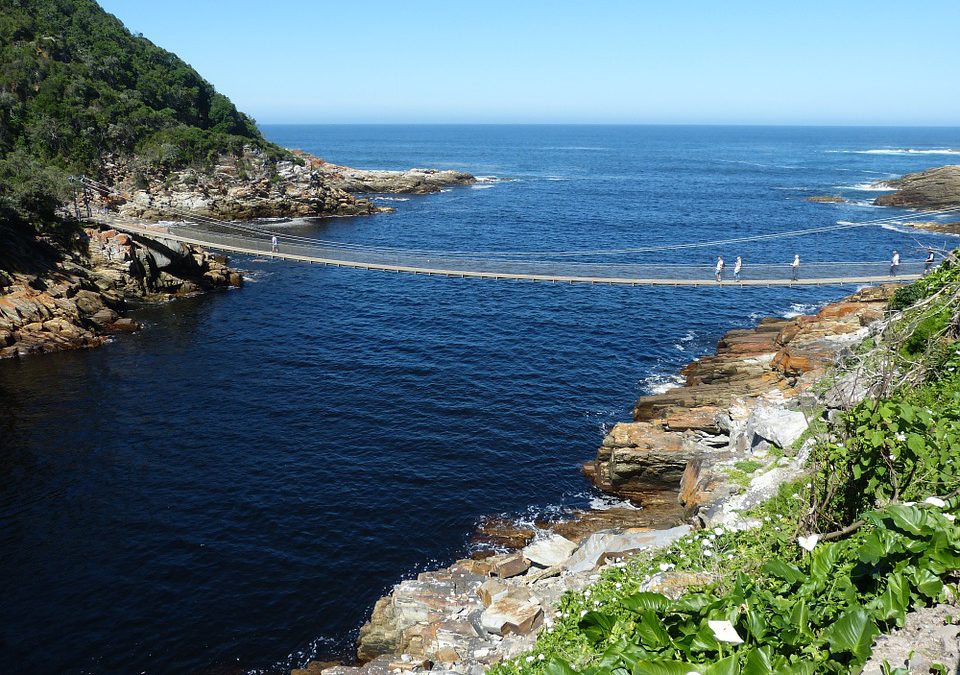This article, written by James Bainbridge, was originally published on BBC Travel
The pretty town of Knysna is the tourist hub of South Africa’s Garden Route region, a 150km-long stretch of beach towns, ancient forests and mountainous scenery on the country’s southern coast. Its tidy streets bristle with travel agents while its guesthouses welcome honeymooners with flutes of South African bubbly. But life here has not always been so agreeable; when Knysna was established in the early 19th Century, the town was built on a fluctuating population of gold panners, mariners, settlers, colonials and fortune seekers.
In particular, timber was in great demand, as wood was needed for ships, for railways leading north to the diamond mines, and for building homes and furniture for European settlers. It was an era of expansion by the Brits into present-day South Africa from the Cape Colony, which had grown around the Cape Town trading post established by the Dutch in 1652.
But the famous Knysna woodcutters – a pastoral group of Boers (ancestors of today’s Afrikaners) that logged yellowwood and stinkwood in the surrounding indigenous forests – did not profit from this boom. They were often exploited by the timber merchants, and eeked out a humble existence in isolated settlements, passing on homespun wisdom to the next generation far from the industrialisation sweeping the rest of the country. Logging was stopped in 1939 to conserve the remaining forestry, and the woodcutters would have become a forgotten historical footnote were it not for the late writer Dalene Matthee. A descendent of the great Scottish author Sir Walter Scott, she wrote four painstakingly researched and vividly imagined historical novels about the area’s forests, including Circles in the Forest (1984) and Fiela’s Child (1985).
Fiela’s Child tells the story of a white foundling, Benjamin, who is brought up on an ostrich farm by a Cape Coloured family before being claimed by the Van Rooyens, a woodcutter family who insist he is theirs. Circles in the Forest is a powerful rights-of-passage story about Saul Barnard, who is torn between his woodcutter roots and his ambitions in the wider world, including his love for the daughter of a hostile British timber merchant. The two stories take place against a 19th-century backdrop of trading ships docking in Knysna, the construction of mountain passes, the decimation of forests, and the gold rush that brought prospectors to the area in the 1880s.
Walking trails
The woodcutters and gold prospectors may be long gone, but travellers can still relive this fascinating historic era through a series of forest walking trails that evoke the vanished world of the woodcutters, winding beneath the canopy along rust-coloured streams dappled with sun and shadow. In the Wilderness section of the 1,200sqkm Garden Route National Park, about 35km west of Knysna, a boardwalk leads to the Matthee memorial and the 880-year-old, 40m-high yellowwood that’s named after the writer. The 3km and 9km Circles in a Forest trails explore the refreshing green environment, passing 3m-high tree ferns, old-growth trees, strange fungi and babbling brooks. The longer of the two follows the creek on a route taken by the gold prospectors. Here, as in other parts of the Knysna forests, it is well worth listening out for the “kow kow” call of the rare Knysna loerie. Found only in these woods, the large bird is a beautiful sight, with its distinctive green and blue colouration, crested head feathers and, when in flight, the red flash of its wings.
To really step into the pages of Matthee’s novels, spend up to seven days following the woodcutters’ footsteps on the 108km Outeniqua Hiking Trail. With accommodation in huts along the way, the hike runs through the moist, high-altitude forests covering the Outeniqua Mountains above Knysna, finishing in Harkerville Forest. En route, the path traverses Diepwalle Forest, which is well worth a day trip if you do not have time for the whole trail. Located about 20km inland from Knysna, this section of the Garden Route National Park offers many opportunities to soak up the forests’ cool, silent atmosphere.
In Diepwalle, three walking trails put you firmly in the worn shoes of a Matthee protagonist on a quest through the mysterious woods. The trails are named the Elephant Walks in homage to the wild elephants that once lived here. These surprisingly stealthy creatures were the woodcutters’ chief foes; the forest-dwelling men may have hated Knysna’s arrogant timber dealers, but they feared only the wrath of God more than the elephants, which could move in silence and attack with speed.
There were once hundreds of elephants roaming this area, but hunting and deforestation have almost wiped out the population, with as few as one or two elephants remaining in the wild. If these odds sound unpromising, head to Knysna Elephant Park, a pioneering elephant rehabilitation centre, 22km east of Knysna, where you can learn more about the plight of the diminished local population through various activities, including guided walks with the resident nellies. The park also has an on-site Elephant Lodge, where the six bedrooms share a lounge overlooking the orphaned elephants’ sleeping quarters.
But to bed down in the fresh air like the woodcutters of yore, head to an unusual campsite near Diepwalle Forest Station in the heart of the woods. The Forest Timber Camping Decks comprise of raised platforms among the trees, making for great spots to scan the canopy for Knysna loeries while theboerewors (beef sausage) sizzles on your braai (barbecue). You pitch your tent right on the platform, each of which has a braai and a sheltered counter for preparing food, and sleep suspended between the treetops and the forest floor. The scavenging baboons and vervet monkeys are less welcome sights – if possible, store food in a car – but are a reminder of the hardships endured by the woodcutters who knew these forests so well.
Lying in your tent, listening to the rustles and chirps of the forest, you can almost hear an old bull elephants whishing his way between the moss-covered trunks and the woodcutters rising early for a campfire breakfast of sweet potatoes and coffee.
Practicalities
The Diepwalle and Wilderness sections of the Garden Route National Park can be visited on a day trip from Knysna. To hike some of the paths, including the Elephant Walks and Outeniqua Hiking Trail, you will need a permit, which can be obtained both at the park and from the South African National Parks offices on Thesen Island in Knysna .
To get to and around the park, you will need your own transport; in Knysna, you can hire cars from Around About Cars and mountain bikes from Knysna Cycle Works. Various companies in Knysna offer guided walks and other activities in the forests, including Knysna Forest Tours and the Adventure Centre.
Knysna is located 500km east of Cape Town, accessible by Translux, Intercape or Greyhound bus. Kulula and South African Airways operate domestic flights to the cities of George, 65km west of Knysna, and Port Elizabeth, 260km east.
About the Author
 James Bainbridge is a British travel writer, journalist and photographer living on the slopes of Table Mountain in Cape Town, South Africa. He is the senior author of Lonely Planet’s guides to South Africa, Turkey and Morocco. His travel articles regularly appear on the BBC Travel website and in publications worldwide. Follow James on Twitter .
James Bainbridge is a British travel writer, journalist and photographer living on the slopes of Table Mountain in Cape Town, South Africa. He is the senior author of Lonely Planet’s guides to South Africa, Turkey and Morocco. His travel articles regularly appear on the BBC Travel website and in publications worldwide. Follow James on Twitter .








